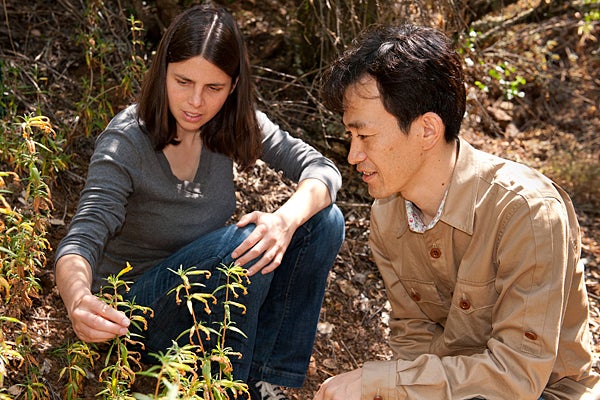|
August 2, 2011
Ditch the cookbook: Stanford's biology pilot project shows benefits from nontraditional lab class
Researchers find that members of the Bio 44Y pilot lab, featuring student-designed projects at Jasper Ridge, were better equipped for future biological research than students in the standard lab course … just in time for the complete redesign of all core biology lab classes. By Max McClure

Lecturer Sara Brownell and assistant professor Tadashi Fukami at Jasper Ridge Biological Preserve, where the study was conducted. (Photo by Linda A. Cicero / Stanford News Service) Though it may make the premeds nervous, Stanford biology will completely overhaul its core lab courses for the 2011-12 academic year. For nearly 20 years, Bio 44X and Y have largely followed the "cookbook" lab model, where students follow standardized recipes for classic experiments.
Now, these syllabi have been dismantled in favor of an "authentic research" approach, allowing undergraduates to pursue individual, original research questions for an entire quarter. And, in case there were any doubts, a forthcoming paper in the Journal of College Science Teaching accompanies the decision: It finds that students in the authentic research class showed more self-confidence in performing lab tasks and more enthusiasm about pursuing authentic research than their cookbook-following friends.
The switch is based on an idea that's been around for more than 40 years. Science educators maintain that high-school cookbook-style classes rarely demand the conceptual skills necessary for actual scientific research. But, despite the support of the American Association for the Advancement of Science (AAAS) and the National Academies for authentic research-based courses, few properly controlled studies have compared student experiences under the two approaches until now.
"It's very rare to have a situation like ours," explained Tadashi Fukami, assistant professor of biology and co-author of the paper. Two years ago, the Biology Department tested the authentic research-based waters with its Bio 44Y "pilot lab" program. While the majority of undergraduates in the core experimental lab studied traditional course content – surveying immunology, animal behavior, vesicle transport and ecology as a way of learning basic experimental techniques – 20 students volunteered for an experimental course headed by Fukami.
Rather than recreate a series of known experiments, pilot students worked in small groups on quarter-long research projects at Jasper Ridge Biological Preserve. Each group studied the effects of different environmental factors on communities of yeast in sticky monkey flower nectar.
Over the course of the quarter, students in both versions of the lab responded to surveys regarding their learning experience – and pilot lab students reported significant benefits.
Recent Stanford PhD graduates Matt Kloser and Sara Brownell, survey designers and lead authors of the study, found that students in the authentic research course were more comfortable making hypotheses, analyzing data and presenting results, in addition to being more interested in continuing basic science research.
"The quality of discussion generated by their presentations was so different," said Brownell. "The pilot students were asking really relevant, high-level questions."
The cookbook lab, on the other hand, often seemed to stifle discussion. "Students knew there was a 'right' answer," said Kloser. "If they didn't get it, they often just complained that something went wrong with the set-up or materials. That's not how science works."
44X and Y were not necessarily the department's most popular courses to begin with. A recent alumni survey gave the labs some of the lowest scores in the major. The retooling, spearheaded by department chair Bob Simoni and based on a model by professors Martha Cyert and Tim Stearns, was meant to give students a more accurate feel for real biological research. It emphasized collaboration and problem solving, and gave students the chance to address an unanswered research question.
As curriculum redesign coordinator Pat Seawell put it, "The idea is that they're actually filling in unknowns in the great database in the sky."
The department acknowledges that the change eliminates some of the variety seen in previous incarnations of 44X and Y. But sacrificing breadth for depth may actually be an added benefit.
"There's a lot of evidence," said Brownell, "that when students do a technique for two weeks – running a PCR [polymerase chain reaction] once, running a Western blot [protein analysis] once – they don't necessarily remember it."
The new approach has already begun to pay off for a number of the pilot lab's inaugural students. For example, an upcoming Fukami lab published online last month in the Proceedings of the Royal Society B features a figure based on data gathered by Bio 44Y undergraduates.
The researchers have recently completed a follow-up study with last year's pilot class, made up of a larger, randomly selected student population. But the real challenge may be maintaining the communal feel of the original 20-person course once a full 100-person class descends on Jasper Ridge in the spring.
"For this kind of approach to work it's very important to keep the students in small groups, so it's going to be a challenge," said Fukami.
The new version of 44X offers similar challenges, with more than 300 students expected to participate in the winter course's focused investigation: a full-quarter examination of yeast with mutations in the tumor suppressor gene p53.
"The great thing," said Kloser, "is that, from the department chair on down, they want to get this right."
Overall, the full-scale rollout of 44X and Y will involve substantial staffing increases and an additional $30,000 worth of equipment. And the tweaking doesn't stop there.
"In five years we'll hopefully rethink the course," said Seawell. "We'll say, 'Enough with yeast, on to the next hot model organism.' Maybe nematodes."
Max McClure is an intern for Stanford News Service.
-30-
|